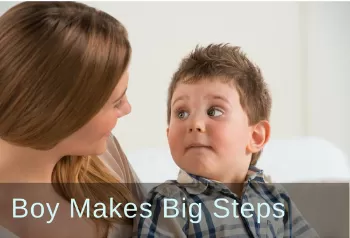Primitive Reflex Integration Case Studies
After 12 Weeks, Boy Shows Greater Interest in Higher Level Cognitive Tasks
Boy with Autism makes Huge Gains in Regulation, Communication, and Behavior
See how this OT used tools learned in the Brain and Sensory Foundations program to help a 5-year-old boy diagnosed with severe autism become calmer and better able to communicate. There was also a reduction of injurious behaviors!
Submitted by C.S. Occupational Therapist

| Before | After |
|---|---|
| Unable to sit still for more than 5-7 seconds | Can sit still for 2-3 minutes and complete a puzzle task |
| Frequently pinches, bites, and hits | Decreased frequency of pinching, biting, and hitting |
| No interest in communication | Starting to identify different triggers such as sound being “too loud” and the lights being “too bright.” |
Ben is a 5 y.o. Boy diagnosed with severe autism.
Ben is non-verbal and was pulled from school when he began developing behaviors such as biting, hitting, and pinching.
Ben spent many months in therapy at a local Children’s hospital in which his mom reports he arrived to therapy each day crying and could not work. Ben is currently in his 12th week of therapy and was one of my first clients as a licensed therapist. In the first 3 weeks, Ben was unable to sit still longer than 5-7 seconds and could not be nearby the therapist, peers, or parents. With the primitive reflex testing, none of Ben’s primitive reflexes were integrated. However, since many of the reflexes are more difficult to integrate, and some overpower others, I decided to begin with the FPR [Fear Paralysis Reflex], Moro [ Moro Reflex], and have put a heavy emphasis on rhythmic movements [from the Brain and Sensory Foundations First Level course].
Ben is a kid with a lot of sensory needs and is frequently only calmed with horizontal swinging in a boat-like swing. I did not want to push Ben to the point that he would not tolerate any rhythmic movements so I began by having mom try to begin rhythmic movements at home (and while Ben was sleeping). Ben has slowly began to tolerate more rhythmic movements and is now tolerating 2-3 minutes of rhythmic movements and 4-5 minutes on a chi machine. Ben currently still demonstrates difficulty with allowing rhythmic movements consistently but has shown a preference for RM 1 and 3. In the last week of therapy services, Ben has tolerated RM 2 on his right side.
Working with Ben has really shown be how important it is to have the client and their reactions guide the session.
I have used “the three thumps” and the monkey hugs [Moro reflex integrations] frequently to show Ben he is in a safe place. Ben toe walks and is extremely hesitant to put his heels down (better since plantar, babinski, and FTG integration exercises in Brain and Sensory Foundations Second Level course). Due to this, I have been very diligent in attempting to integrate the TLR reflex [Tonic Labyrinthine Reflex] to give Ben a sense of grounding and balance in his vestibular system via time on his stomach and activities including rolling, rocking and spinning. Ben has shown interest in more horizontal rocking which has been used in our session. However, as Ben leads our sessions, he has shown greater interest in higher level cognitive tasks.
In the last 12 weeks, Ben has developed the ability to sit still for ~2-3 minutes and complete a puzzle task while activating the LAMP program on an iPad for appropriate communication. Ben has also decreased the frequency in which he pinches, bites, and hits during sessions. Ben has been crying less frequently and has demonstrated the ability to identify different triggers such as sound being "too loud" and the lights being “too bright”.
Using the rhythmic movements and beginning with building a firm foundation for Ben’s skills has shown me that, contrary to popular belief in graduate school, occupational therapists do so much more than fine motor.
"Ben’s mom has indicated this is the first time he has ever functionally attempted to communicate and this is such a big step for Ben."
Therefore, I will continue to encourage mom to incorporate rhythmic movements into their daily routine and to see a holistic health practitioner (as his gut seems to be complicating his progress [i.e. constipation, cramping, poor diet]). Sonia, I can’t thank you enough for giving me a way to get a glimpse into this little boy’s world and to help him in a way I could have never imagined.
[Edited for length and clarity; emphasis added]
*Disclaimer: The activities in the Brain and Sensory Foundations curriculum make use of the natural processes of neuroplasticity and development that are innately wired in the design of human beings to promote maturity and function. These activities appear to calm, organize, and mature the neuro-sensory-motor systems just as we see in the healthy development of human infants. Individual results may vary, and we do not claim to offer a diagnosis or cure for any specific condition or disorder. The Brain and Sensory Foundations activities appear to improve overall functioning resulting in measurable improvements for a range of conditions as demonstrated in over 1800 case studies from participants.

